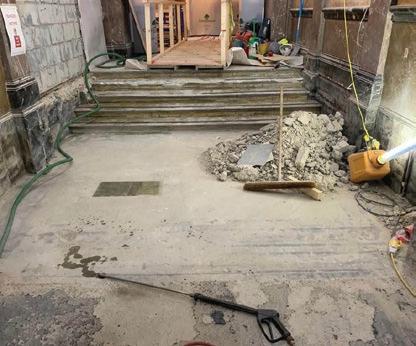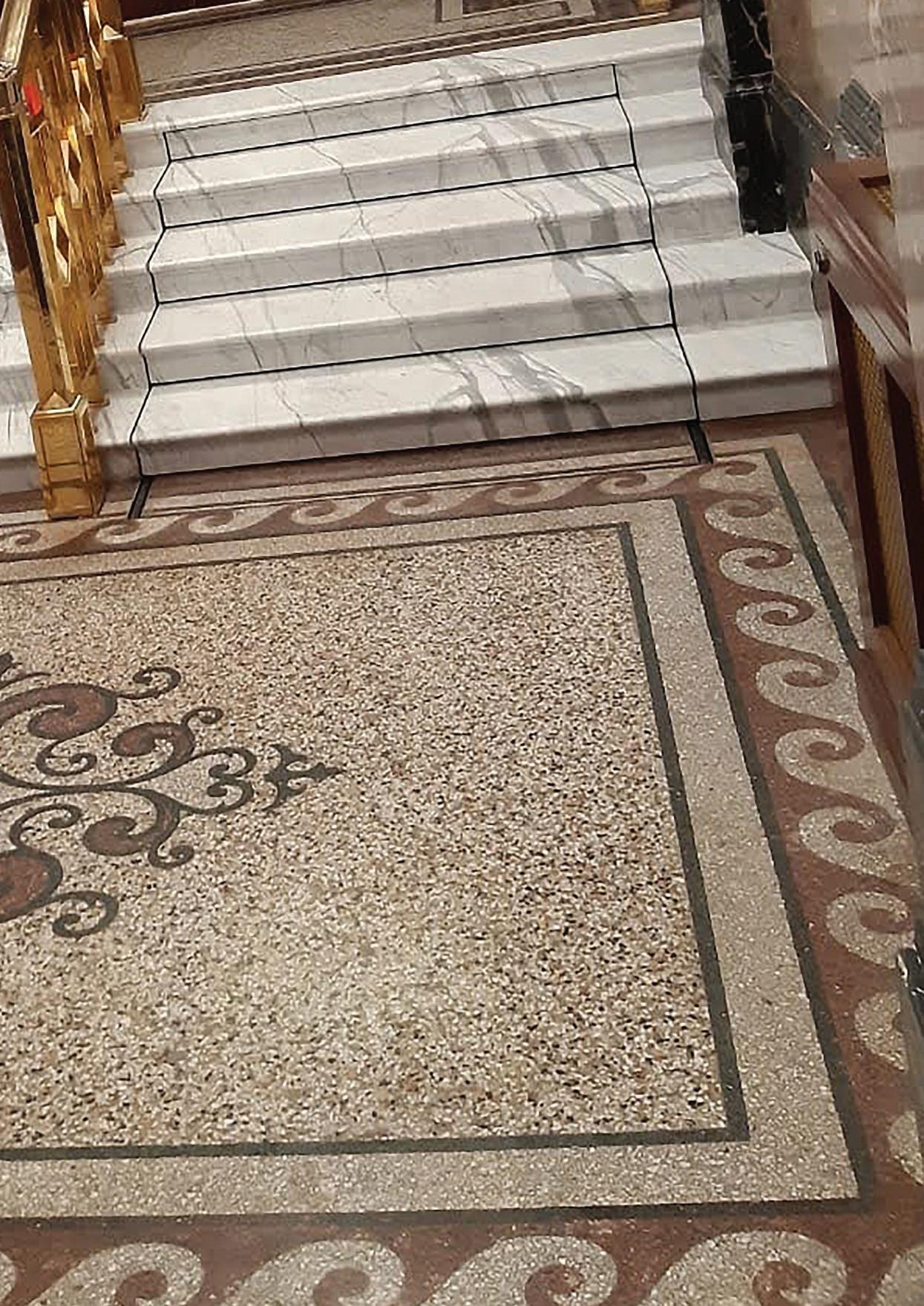
5 minute read
Entrance insights
Entrance & Lobby Refurbishment Arriving at the Farmers Club visitors are now welcomed by a marvellous entrance and lobby area. Stephen Skinner explains this significant renovation project
The ramp and steps in their position before the work commenced – but this was not the original position of the steps.
With the steps and ramp removed, along with many tonnes of rubble too, the marble steps in their original position are exposed and, incredibly, a fine terrazzo floor.


After Superior Stone had weaved their magic, the full splendour of the long-hidden terrazzo is brought to life.
“ROME wasn’t built in a day” may be a medieval French phrase yet it is strangely apt in the case of the Entrance & Lobby Project. Time it certainly took from inception but the result has been worth made an uninterrupted contribution to the image of
waiting for.

The refurbishment of the Entrance and Lobby of No 3 Whitehall Court had been scheduled for the building’s major works programme in 2002, but not until ten years later did the project get underway in earnest. Architects were appointed, and after extensive research into the original design and the many alterations that had occurred since 1883, a plan emerged to reinstate original detail where possible, to provide sympathetic updating and to enhance access.
Even after the designs had been approved by local planners and by groups dedicated to preserving Britain’s architectural heritage, the final details continued to evolve. Changes in configuration of the porters’ lodge, design of the terrazzo flooring and changes in quantities of marble and other stone meant years were added to the project.
London landmark
Through it all, the ambition to reinstate the character of the entrance and lobby of an important London landmark was never lost.
The architecture and engineering of Whitehall Court represent one of the most significant design achievements of Victorian London. As one of the first steel and concrete buildings in the country, and as one of the tallest mixed-use structures of its day, it is protected by its Grade II* listing as an important historic site.
Yet, while the exterior facades and roof line have 12 • The Farmers Club Harvest 2020
London along the Thames for 137 years, the lobby and entrance had been much altered since the original construction, and often not for the better. Long-delayed maintenance and patchwork repairs had tarnished the character of the interior.
Unveiling it all
Rotating doors had been added in the 1970s. Carpet had covered the intricate terrazzo flooring. Skylights and windows had been blanked out. Heavy traffic had damaged faux marble details and heavy smoking had stained the white Carrara marble ceiling a dirty brown. Marble steps and panels and alabaster cornices were damaged or missing. Poor lighting contributed to a dirty, dingy appearance.
Symbolic of the state of maintenance and repair was a “temporary” wooden ramp for users of wheelchairs, baby carriages and wheeled luggage. It had been in place for more than a decade.
In 2016 as I was leaving The Farmers Club, I was invited to serve as Project Co-ordinator for the refurbishment because I knew many of the people involved, I knew the building well and had just seen Project CREST through to conclusion (well, nearly anyway). This part-time role brought enlightenment and frustration in equal measure.
The result, with a lift hidden into the stairs for people who need assisted access. But this is just one part of the work carried out.

Numerous layers of old magnolia paint are stripped back to reveal original marble panels.


Steel columns supporting the building within the Lobby stripped of their faux marble.

Columns being dressed with lining and then 8mm marble veneer in the Lobby. New area of terrazzo flooring being created in the Lobby where only a cement floor existed previously, covering a lightwell.
After a couple of false starts, and the withdrawal of our architects just as work was about to start, work finally began on 29th April 2019.
CLUB IS OPEN thefarmersclub.com
The right experts
The late withdrawal of the original architects gave rise to our very great good fortune to bring on-board Mr Clive England of Thomas Ford and Partners. Clive’s experience of working with historically significant buildings, along with his leadership, brought the project back together. Additionally, we were fortunate to have Grangewood as our principal contractors (ably led on site by Neil Jordan), along with Superior Stone who carried out all the stonework to the highest of standards.
Superior Stone’s Andy Thomas proved particularly adept at sourcing stone and alabaster, although unfortunately not from the same quarries as the original stone used in the 1880s. Andy bought in marble, onyx and alabaster from Spain, Belgium, France, Iran, Mexico and Italy. Interestingly the original alabaster was quarried in Yorkshire but these quarries are now extinct. Fortunately, the Portland Stone for the entrance ramp from the pavement was sourced in the UK.

Light levels
The electrical and lighting issues proved particularly challenging. The planning permission did not allow for any new holes to be made in the marble walls or ceiling. Prolec, our electricians, and Sutton Vane Associates, the lighting consultants, have delivered a scheme that raises light levels to meet contemporary requirements while remaining in character of the original design for a late Victorian gas-lit public space.
To get a real sense of the finished article you should of course visit 3 Whitehall Court. In the meantime, the photographs give a sense of the changes that have taken place during the refurbishment.
Stephen Skinner Project Co-ordinator &
Book bedrooms, restaurant, meetings and functions at your Club now.
www. thefarmersclub.com
e-mail:
reservations@ thefarmersclub.com restaurant@ thefarmersclub.com functions@ Ex-CEO & Club Secretary of The Farmers Club
020 7930 3557
The Terrazzo finished and polished… a masterpiece of restoration, returning the entrance and lobby to the
original splendour envisioned by its Victorian creators.












